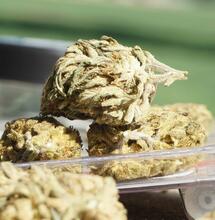Ultimate Root Zone!

The first few days of a plant's life are often overlooked but are among the most crucial to success. Getting the best root system possible at this stage will not only increase final yield dramatically, but also give a healthier plant in general.
The first few days of a plant's life are often overlooked but are among the most crucial to success. Getting the best root system possible at this stage will not only increase final yield dramatically, but also give a healthier plant in general.
The first few days of a plant’s life are often overlooked but are among the most crucial to success. Getting the best root system possible at this stage will not only increase final yield dramatically, but also give a healthier plant in general.
This in turn allows you to make the most of your time and space with a faster growing plant able to support more flowers. Here we outline the ultimate method to get an outrageous root system in your plant from day 1.
We will cover how to easily make a home-made hybrid dripper system with integrated air pruning, which makes young plants produce an abundance of fresh healthy roots. Also we’re going to explore in depth the optimum nutrient feeding regime, so your young plants will get further, faster with their first tender steps. Kind of like a kindergarten for your little green babies.
Shopping List
To get the Ultimate Root Zone using this system you will need to aquire the following (you may already have a lot of this kicking around):
• 3 Inch Rockwool cubes (1 inch hole, standard height)
• Peat pellets (disks of dried compressed peat that expand in water)
• Large plant tray - must be at least twice as large as the space needed for your rockwool, at least 3 inches deep and watertight.
• Smaller plant tray for tiny seedling stage (optional)
• A hard metal screen to sit on top of the large plant tray (cheap greenhouse shelving works well)
• A mid-size pump suitable for dripper systems
• An in-line filter between the pump and dripper manifold
• A dripper manifold, to split the drip tube to each plant
• Dripper tubing (buy a couple of metres more than you need)
• Dripper stakes
• 24 hour timer, in 15 minute segments
A gentle weaning.
There are plenty of articles about cloning and planting seed, so right now let’s skip that and assume you are already gleefully about to take some cuttings or plant some seeds in preparation for the next crop.
All healthy root zones are born from a high quality soil or hydroponic substrate. Every seasoned grower has their own favourite first planting medium, whether soil, rockwool, perlite, clay pellets or coco; pretty much any of these work just fine. But we don’t want to settle on “fine”, we want the ultimate!
Peat Pellets with no added NPK nutrient for the first couple of days give the best start to many of our favourite plants. Peat pellets are full of natural gentle nutrients, so by using them at this early stage we give an organic weaning when the plant is at it’s most fragile (this will ease the transition If you switch to mineral feed later in the grow). It also has a little more moisture retention than rockwool, which we will use to our advantage in the next few stages.
Soak the peat pellets in some warm water, pH adjusted to 5.6. At this stage you should not add any NPK fertiliser, only add a little root booster (Rhizotonic or similar). Adding Trichoderma fungus at this stage too (Biopak/Aktrivator or similar) adds an amazing secondary root system that grows with your plant’s own roots, allowing more efficient nutrient uptake and also guarding against pythium and other substrate horrors! Using a good enzyme product throughout the cycle helps the rhizosphere stay healthy, process dead tissue and convert it quickly into nutrients.
Fast flushing of rockwool.
After the first roots peek out from within your peat pellet it’s time to transplant into your rockwool cubes. Before you do this you need to remove the residual lime present in the rockwool from manufacturing. This must be flushed out fully to prevent the substrate’s internal pH being raised way too high.
A common misconception is that rockwool progressively raises the pH of your plants, this is untrue as rockwool is pH stable once flushed properly. The reason pH can rise in the substrate is actually due to the plants active growth and is a good sign (as long as you correct it back down before it gets too high!). More on this later.
Common practice is to soak rockwool cubes overnight, but this is overly time consuming. Much faster is a three stage flush:
• First soak them in hot water, squeezing them around, and generally being a little rough with them to break the cubes up a bit, giving a fast flush of the lime. Leave them to soak for 5 minutes then squeeze the cubes out and discard all this liquid.
• Flush two is in hot water again, you can treat them nicer this time, just a few light squeezes under the water then let them soak for half an hour. Discard this water.
• The third flush is done with lukewarm water adjusted to pH 5.5 in which they’re left to soak for half an hour. Discard this solution and squeeze most of the liquid out of your cubes. Now your rockwool is ready to receive nutrients & plants!
Because our babies have already got roots peeking out from the peat pellet, we can now prepare a very light solution of NPK veg nutrients, root booster, seaweed extract and trichoderma for the rockwool – at this stage we only take the mix to 1.1 EC from seed (1.2 EC if from cuttings) and bring the solution to pH 5.5. Soak your rockwool cubes in this solution for an hour. Carefully drop your plants into the rockwool, gently close up any gaps between the peat pellet and rockwool, then sit back and feel pleased with yourself.
Make your rootin’ tootin’ root boostin’ hydroponic kinder-garten!
Now it’s time to assemble our incredible Ultimate Rooting hydroponic system. We will only keep the plants in this system for a week to ten days, but it gives them the best start possible before you install them in their final home. Nutrient solution is pumped through the rockwool, dripping out from underneath into the tray to create a recirculating active system.
The magic comes with the screen – as the roots grow through, they hit air and the tips die off triggering an explosion of new root growth from within. We time the feed schedule and adjust the nutrient composition to encourage the most extreme roots possible before we transplant to their final site.
Sterilise your trays, pump and screen. Diluted Hydrogen Peroxide or isopropyl alcohol works well and doesn’t leave any residue that’s unfriendly to plants. Put your small tray down on the bench and attach your pump to the base, towards the back end of the tray and away from the centre. Lay your screen over the tray. Next fit your inline filter to your pump, then your dripper manifold and tubing. The pump filter and manifold should be sticking up through the hard screen.
It is useful to use the smaller plant tray at this early stage, as you won’t need to make up such large quantities of feed just to get the depth high enough for the pump to work efficiently. Using less nutrients is also more economical for you and better for the environment too with less waste solution. As the plants grow too large for the small tray you can simply lift the screen, pump, plants and dripper in one convenient movement and swap the bottom tray to a larger one.
If your screen is unsupported anywhere you can place a couple of metal rods laying across the top of the tray under the screen, supporting the weight of your wet rockwool. Alternative methods are to fold the screen edges carefully up to give some rigidity or better yet just get a larger screen and cut it to fit, leaving an inch or so of overlap all around the large tray.
Think about your plant spacing and cut your dripper delivery tubing to reach each plant easily, but avoid leaving masses of excess to get in the way when they are tiny and bunched closer together. Depending on what you are growing, you may need to allow for up to a 12 inch circumference of space per plant by the time you are ready to transplant again in about 10 days.
Now it’s time to install the plants. Place them directly onto the screen and push a dripper stake into each rockwool cube. It’s easiest to work from the closest to the pump outwards. If you’re working with seedlings they are still absolutely tiny at this stage so you can bunch up the cubes to make the best use of your light coverage. Space them out as they grow, so none of the plants ever touch each other at this early stage. If young plants feel restricted they won’t develop such good lateral branching.
Optimising your feed schedule strength and timing
Make a full spectrum vegetative nutrient solution with NPK+micro nutrients+root booster. We still keep the solution light at this stage, so we mix until we measure 1.1 EC for seedlings, 1.2 EC for cuttings. Tip this into your tray, which conveniently acts as your tank too. Test the pump & dripper are working as expected, with even flow from all the dripper stakes.
The nutrient solution should fill each cube and drip through back into the reservoir from multiple points on the base of the cube. Ensure that the dripper tubing isn’t pulling the stake back into the plastic wrapper on the rockwool, or you risk some nutrient running down the outside and missing the young plant altogether.
If growing from seed, increase nutrient strength to an EC of 1.2 after they’ve been in the rockwool for 3 days, and keep it there until transplanting next week.
Often when people use dripper systems, they use a very fast timer to only replace a small amount of nutrient per feed. This approach will lead to inaccurate pH measurements, as when the plant grows, the pH inside the cube raises too. By only replacing tiny amounts of nutrient at a time you are simply compounding that problem! But by running the pump for 15 minutes at a time it allows the fresh nutrient to permeate through every part of the cube, pushing out the old solution. You should see it dripping out from different points across the base.
When plants are first installed in the rockwool the roots will be minuscule inside the peat pellet, so we only run the pump once a day for 15 minutes in the morning, as we want the cube to dry out slightly over the day to stimulate root growth. As soon as you see the first roots come out of the base of the rockwool cube, run the pump twice a day in the morning and early afternoon. When these first protruding roots have withered and died back and you see the following reactive cluster leaping out of the base you know the system has worked. Keep the feed strength at 1.2 EC, pH at 5.5 and feed this 4 times a day, 15 minutes each time. Have the last feed about 2 hours before lights out.
Peek down the side of the plastic wrapper and you should see a mass of pure healthy white roots, looking like the cube in the picture. The plants are now ready to transplant into their final home. Enjoy your massive yield!As the plants grow you will see the most outrageous root system emerge. Allow the roots at the bottom of the cube to die repeatedly and hold your nerve… Keep them on the screen for about another week, until the cube is literally carpeted in fresh vibrant roots. Increase the number of feeds a day gradually over the week, judging how long it takes for the cubes to feel lighter. By the time you move the plants on you will need to feed about 8 times per day (in an 18 hour day), as there are literally too many roots to fit in the cube and it will be thirsty and dry out fast; this is why the extra water-retentive properties of the peat pellet works in our favour now, by holding a little extra moisture for longer right at the core.
baronwasteland@gmx.co.uk



